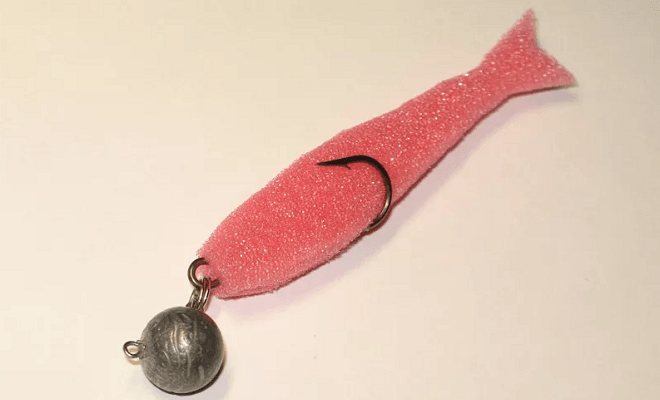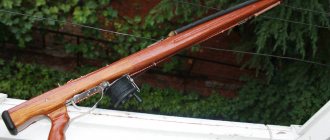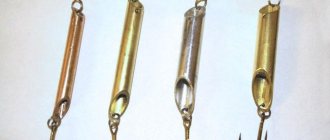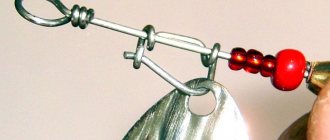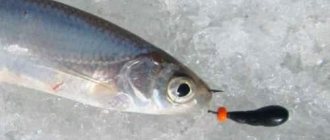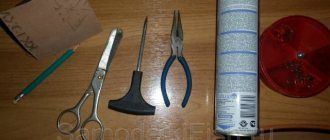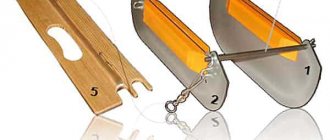Pike, like other predatory fish, prefers to wait for its prey at the bottom. Therefore, a good catch can be achieved by jig fishing. Silicone baits are often used, but fishing with foam fish will make fishing no less productive.
Fishermen can be proud of this Russian invention, and all thanks to spinning player Sergei Pavlov.
Peculiarities
A foam fish or foam rubber is a bait most often used for fishing for predators. Resembles the shape of a small fish. It is made of foam rubber, thanks to its porous structure, the fish does not sink and retains its buoyancy in the water, which distinguishes it from other baits and attracts the attention of toothy predators.
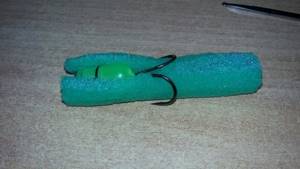
Most often pike perch bite, but of course pike and perch. The foam rubber is easily saturated with water, so it must be wrung out periodically.
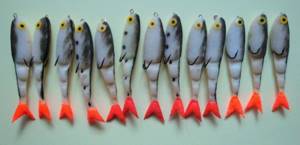
Foam rubber is a fairly inexpensive material and can be easily processed, so making a foam rubber fish with your own hands is not difficult.
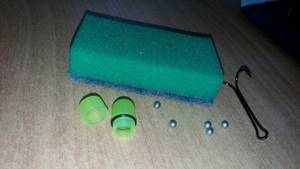
Advantages and disadvantages
The advantages of foam fish are as follows:
- Easy to make bait. A foam sponge, a minimal set of tools and the fish is ready.
- Phenomenal catchability.
- Versatility. Using various methods of equipping the bait, you can catch it both on a clean bottom and in places with many hooks. Another advantage is the possibility of use at any depth, in currents and in standing reservoirs.
- Outstanding flight characteristics.
- Positive buoyancy. A bait standing vertically on the bottom attracts a predator much better than one lying passively on it.
- Indestructibility. Foam rubber, due to its dense structure, can withstand many times more bites than silicone baits.
- Possibility of using attractants.
- Cheap bait.
There are practically no disadvantages to foam fish. The lack of its own game can be considered a disadvantage , but this is due to the physical properties of foam rubber. As a result, foam fish are not used in spaced rigs. Some of the disadvantages of foam fish include its limited use when catching different types of predatory fish . Still, the main trophy when fishing with foam fish is pike perch. Pike and perch are more favorable towards silicone baits.
Application of attractants
Due to the irreplaceable ability of sponges to absorb liquids, attractants can be successfully used for fishing. An attractant is a substance that attracts predators to the source of an odor.
One of the most effective is to soak the fish in blood by cutting the gills and letting the blood flow. But many do not consider this method humane and are inclined to other options, for example, garlic, anise or even fish oil.
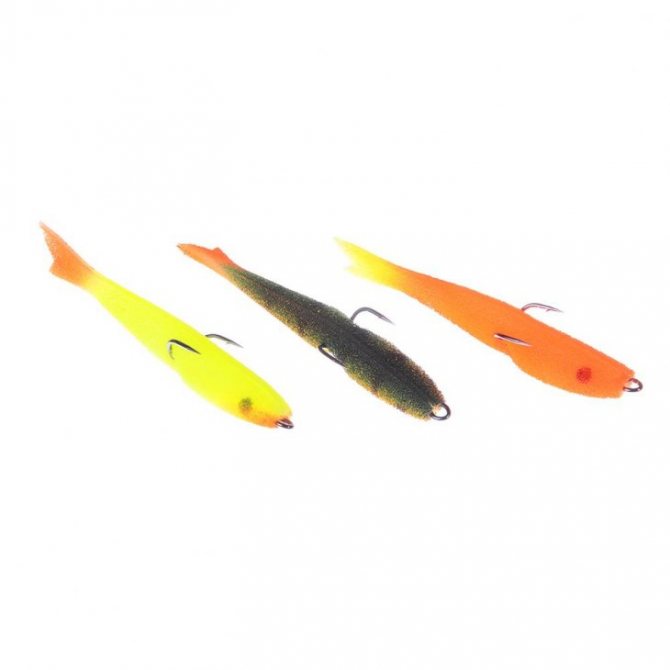
You can make the attractant effect last longer by mixing fish blood with salt and silicone. To make the fish more noticeable, glitter is added. Attractants can be found in a specialty store.

Despite the very unpleasant smell of the substance, fishing can please you with a large catch.

Buy a foam fish or make it yourself
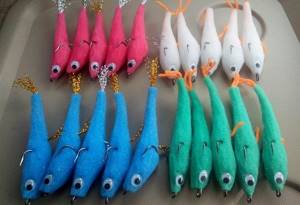
As we have already noted, foam rubber bait can be factory-made, which can be purchased at a fishing store, or made independently by the efforts of the fisherman. As a rule, the dilemma of choosing to make it yourself or buy a ready-made simulator only faces beginning spinning anglers who do not yet have sufficient fishing techniques and have no practice in fishing with foam rubber. Experienced spinning anglers try to independently cut baits suitable for fishing conditions, taking into account the preferences of the predator being caught in a particular body of water.
It is more convenient for beginning spinning anglers to practice their fishing skills on a factory-made product, and then, taking into account certain nuances of their own fishing technique in conjunction with the preferences of the fish, begin to independently produce an effective bait. For example, an avid fisherman takes a piece of foam rubber and scissors directly to a pond, preparing a suitable simulator on the spot in real fishing conditions, and is almost never left without a catch.
Fishing technique
Foam fish are used when fishing with jigs and spinning rods. For installation, the foam fish itself and a weight with ears are used. If you use a Cheburashka, you need to add a couple of winding rings.
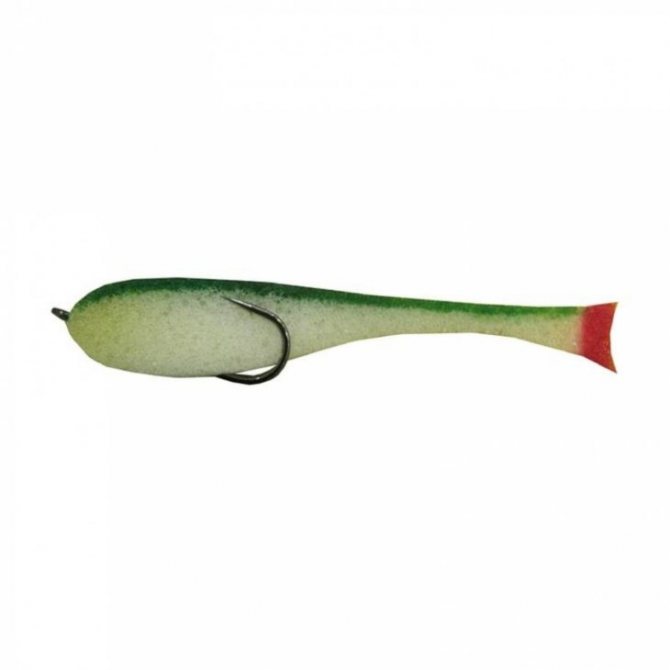
Very often, stepped wiring is used, since it is convenient to make several turns of the reel and then stop so that the bait sinks to the bottom. Russian fishermen use this method.

The American method of jig-spinning is also common: sharply pulling the bait from the bottom, pick up the slack in the reel cord. Using various installation methods, you can fish with a foam fish in hard-to-reach places.
What is a foam bait?
Foam rubber baits are a copy of a small fish, which is equipped with a hook and complemented by a sinker necessary for the fishing conditions. Most imitators are painted in a variety of colors to arouse the interest of the predator. The porosity of the material contributes to the positive buoyancy of the fishing tool, and also makes it possible to saturate the body of the artificial fish with all kinds of flavors.
Foam fish do not have their own game, and fishing with this kind of tool will require the spinner to master a certain bait animation technique, which will vary depending on the type of predator being caught. The natural mass of the simulator is very small and requires a mandatory load, but you can experiment with sizes in a wide range. Therefore, among the foam rubbers, you can choose an option both for ultralight fishing for small perch, and a sample for a heavy jig for hunting for trophy pike.
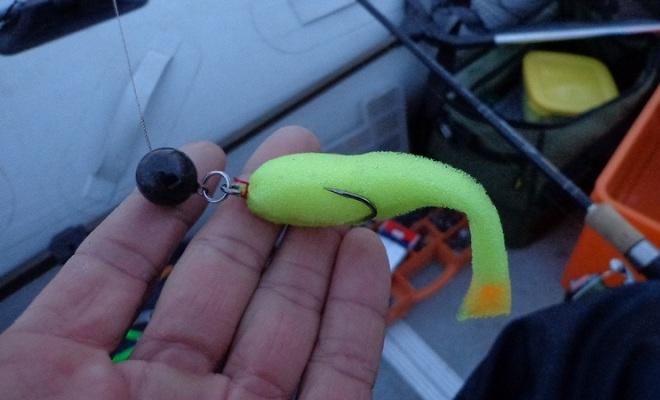
Equipment
The size of the fish is also important, it depends on the size of the hook on which it is planned to be mounted.
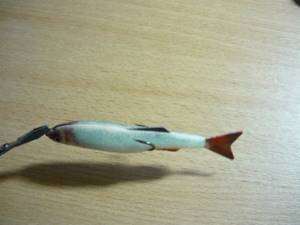
Foam rubber fish can be equipped with: a regular single hook, offset, double or triple. For easier rigging, it is better to cut the fish on the back.
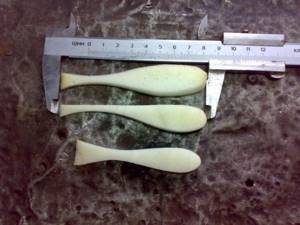
Invariably, the best sinker was and will be the Cheburashka, although modern collapsible weights can be very convenient if you need to quickly change the bait. The shape is not particularly important, however, it is better to use a streamlined one.

To get better acquainted with this Russian fishing invention, look at the photographs of foam fish.
Note!
- A nod for do-it-yourself winter fishing - how and what to make good gear from. 115 photos and video tips from the pros!
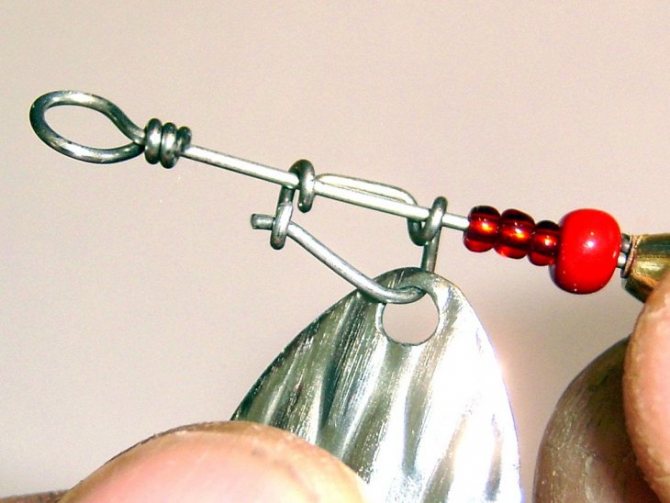
Do-it-yourself spinners - types, features of homemade spinners and their assembly (100 photos and videos)
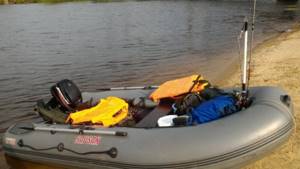
How to minimize fishing costs? Useful tips from experienced fishermen and an overview of current solutions (65 photos)
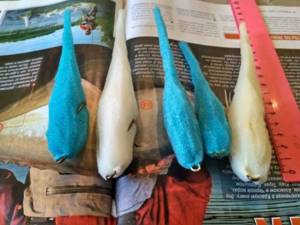
Know-how and experiments
In a front-loaded tail spinner with a petal, foam rubber helps to make the bait play smoothly and protect the slightly bent tee tips from snagging (photo below).
I often make foam fish with a polyurethane head. When installing, it is better not to open the head with a blade, but to make a hole in it for the hook with an awl. Then we place it on the forend with glue and then glue the foam rubber body (some even pierce the foam rubber itself, rather than cut it). In this case, an important detail: the tips of the hooks should be as far away from the head as possible, otherwise there will be many idle bites.
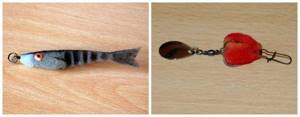
Just my idea - after placing the hook, a rectangular polyurethane wedge is glued into the belly. First it sticks out from the abdomen, and after drying it is trimmed along the contour of the body with scissors. When paused, the fish rises above the bottom even during the current. I do it often; Both catch well.
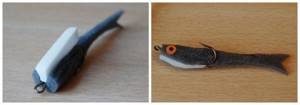
Elephant fish with a slanted muzzle and a thin plate of the same foam have so far been tested only in the bathroom. A slight trembling of the tail is noticeable on the uniform. When stopping, the fish takes a vertical position and then behaves quite unusually - it makes several rather sharp damped oscillations around its axis to the right - to the left: its eyes only flicker. Let's see if this will tempt the fish.
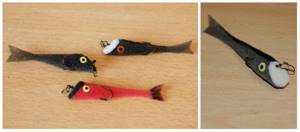
A foam fish with a twister (and other) tail always takes a horizontal position in the water by loading its body with glued lead pellets or a plate. The idea was to arrange something like bottom twitching and dragging with stops at great depths - a metal leash clings to the winding ring of the bait. When retrieving, the fish hovers above the bottom without touching it at a distance of the length of the lower leash leading to the sinker (of course, there is no need to use a metal one). I have seen more than once how some specialists caught predators using a lead rig - the Ob classic with bait in the form of a small wobbler. I tried it a long time ago, I remember everything was confused with the tees - that’s actually what inspired it. It hasn’t been caught yet for the reason – I didn’t get around to it.
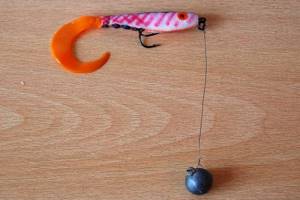
The last four options with elements made of polyurethane foam are perfectly suitable when using “feeding fish” wiring. In the original version, a sliding weight and two beads on its sides are put on a 30-50 cm piece of fishing line or fluorocarbon; A bait - a foam rubber fish - is tied to one end of the fishing line, a swivel is attached to the other, and a cord is attached to it. For a freer passage of the line, and therefore a sharper play of the bait, I prefer to use sinkers with a wire loop - the same Cheburashkas, for example. The cast is made. Let the load fall to the bottom and begin to release and pull the cord with smooth or sharp jerks. That. After playing on the spot, we reel in a meter or two and start the game again. It turns out to be a kind of drop shot in reverse - not with a gliding bait, but with a pop-up bait. In this case, fishing is carried out as if with an overload - i.e. the load must be heavier than what would normally be used at that depth. If foam rubber is used as bait in this equipment in a small current, then polyurethane foam or its elements can be used both in still water and in fast currents. The small internal diameter of the holes of the sinkers and beads, as well as thick cord and fishing line, can nullify all efforts. Lure options when using such wiring are a solid polyurethane fish (its disadvantage is that there are occasional overlaps when casting with the main line due to protruding hooks and the impossibility of making it in a non-hooking version) and a combination of a polyurethane head - an offset or regular hook on a rigid or flexible wire bunch. Edible rubber is usually used as a hook attachment. The disadvantage of this method, like the drop shot - the inability to resist pike teeth - in this case I try to eliminate it by installing a 3-4 centimeter wire leash with a large loop in front of the head, which allows me to abandon the use of beads, which makes the movement of the bait more free.
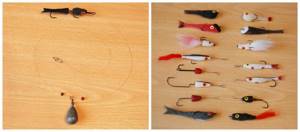
Since the topic has already been touched upon, I would like to say a few more words about the closest relatives of foam rubber - polyurethane foam fish. The baits are seasonal, working from early spring to the end of May, in the fall from September until freeze-up. The objects of fishing are primarily pike perch, as well as pike and burbot. Unlike other baits in white, they catch fish in brown clay water (which happens when the Inya River floods in the spring, if anyone knows). Since the early 2000s, all sorts of variations have been made. The manufacturing material is very dense, so you always have to move the hook tips away from the body for better grip. As mentioned above, there can be no talk of any non-clinging materials in their pure form, although due to their buoyancy they cling less often than foam rubber. At first, the fish were made in two parts with two doubles or tees and were quite large in size; in the form of several barrels with lurex (like the newly-minted mandulas). The most effective were small 5-6.5 cm narrow-bodied single-piece fish with a tail in white, less often black and gray colors. The blanks are also cut with a knife, and the bait itself is cut with a blade. Glued together with instant or superglue. The latter is undesirable in the case of a thick body and small hook size, since it forms a very rigid seam. Fine-pored polyurethane is primarily used for travel mats, soft multi-colored hoops and sticks in sports departments, Chinese slates - in some regions this is what they call fishing with “slippers”; gray - insulation for pipes in households. stores But the large-porous one with bubbles, similar to polyethylene and so reminiscent of scales, but very hard (above in the third photo from the bottom left) has not proven itself in terms of bites.
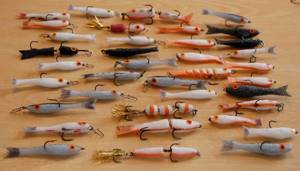
This is what it is - Foam rubber and its varieties. I caught it. Catches. And he will catch. And how much pleasure you get from catching fish with bait you made yourself!
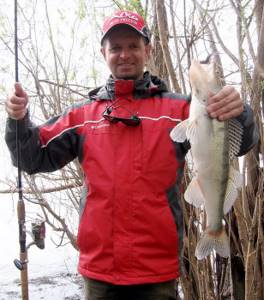
Have fun with the foam fish - it's worth it!
With uv. Sergei Sidorov
Photo of a foam fish
Note!
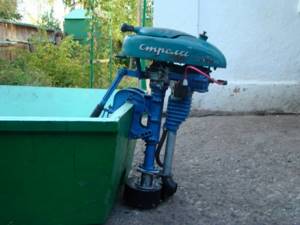
Do-it-yourself boat motor - tips for beginners, projects, drawings and step-by-step description of the construction of the main components and elements (video + 120 photos)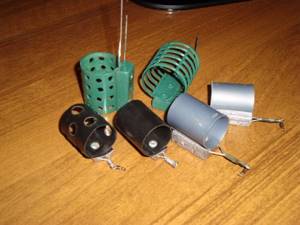
Feeder for winter fishing - secrets of use and techniques for feeding fish in winter (115 photos)
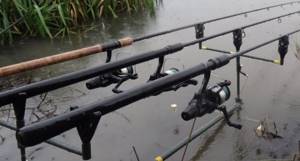
Bottom gear - the most effective types of equipment and features of casting techniques (95 photos and videos)
Read here Do-it-yourself bloodworm - how to make it at home and strengthen it for winter and summer fishing (115 photos + video)
Help the project, share on social networks 

0
Hook mounting
The shape of the final product does not affect the type and size of the hook used for rigging. An important factor is the length of the workpiece, comparable to the size of the hook. Tees, doubles, offset hooks and single hooks with a long shank are suitable for rigging foam rubber. Single hooks with a long shank are used for fishing in clean waters, where the likelihood of snags is very low. The fish is pierced with a sting and strung on the fore-end, or by cutting the foam rubber, the hook is glued directly into the body of the simulator, leaving the point protruding from the back free.
An offset hook is used to create a non-snagging hook. The foam rubber is mounted on a hook by analogy with a vibrating tail or, as in the case of a regular hook, it is glued into the cut body.
Doubles and tees are glued into the body of the fish, making a longitudinal cut on the back or tummy of the simulator. The only difference in installation is that initially a through puncture is made with one of the hooks of the tee a little further than the end of the cut.
Tips for rigging hooks
When installing bait on a hook, I would like to focus on a number of important nuances that improve the reliability of foam rubber fastening in installations. Long, large-sized baits, which are more typical for foam rubber lures for pike, are attached to hook options with an elongated shank. Such design features of the accessory are available not only for single hooks, but also for tees and doubles.
If there is a need to equip foam rubber with two triple hooks, then the installation includes a wire frame glued with a loop, connecting the hooks to each other through their fastening rings. Thus, by connecting the bait to the main line through the front hook and sinker, the reliability of installation of the entire equipment is ensured.
Painting
Predator baits look more impressive and attractive after painting, although some fishermen do not see any particular advantages in painted imitators, using them in the natural colors of the blanks. But it is worth noting that if you fish on currents, where the fish quickly reacts to the rig, without particularly understanding the nuances of its shape and color, color design is not important, but when fishing in stagnant reservoirs, a promising color can provide additional advantages.
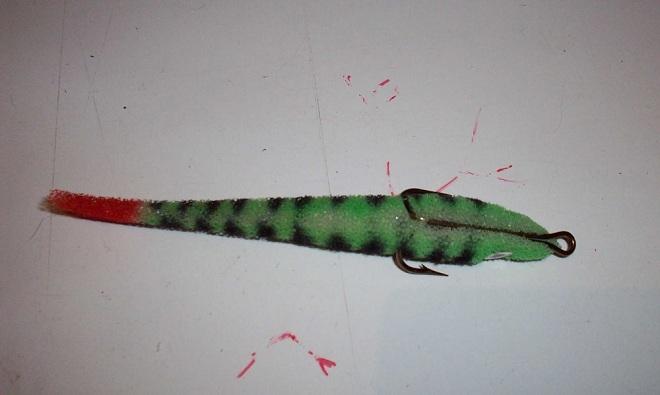
The easiest way to add war paint to a fish is to use permanent markers for this purpose. This paint is not washed off with water, and on light-colored workpieces it looks distinct and bright, allowing you to draw attack points, which is especially important when making fish for pike perch or pike perch. The final choice of color or lack thereof is entirely up to the fisherman.
Sinker
Due to the inertia of the foam rubber, a stationary jig head is not effective for this type of installation.
Important! The best attractiveness of baits is given by the combination of foam rubber with a hinged weight.
Cheburashka gives more degrees of freedom to the imitator, which increases the number of bites. In addition, this type of shipment favors the quick change of nozzles, and the use of various forms of weights increases the aerodynamics of the installation and its maneuverability in overgrown and snags. The weight of the cargo is taken based on the fishing horizon. Heavy loads deliver the rig to the desired water level faster, thereby saving time for the bait to reach its operating parameters.
